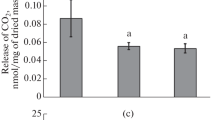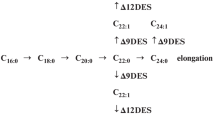Abstract
The objective of this work was to elucidate a possible adaptive role of lipid biosynthesis and unsaturated fatty acids (FAs), esterified to lipids, as terminal acceptors of electrons, alternative to molecular oxygen, in the shoots of rice seedlings (Oryza sativa L.) under conditions of strict anoxia. Biosynthesis of lipids and their accumulation, as well as the reduction of double bonds in unsaturated FAs, were studied by electron microscopic observation of the accumulation of lipid bodies in the cytoplasm and by the biochemical analysis of FAs in shoot lipids before and after anaerobic incubation of the shoots. The experiments were carried out with intact coleoptiles after 5 and 8 days of anaerobic germination of seeds (primary anoxia) and with detached shoots, preliminarily grown in air and then subjected to anoxia in the presence of 2% glucose for 48 h (secondary anoxia). In these experiments, lipid bodies did not accumulate in the cytoplasm under anoxic conditions. Lipid bodies appeared only during 48-h anaerobic incubation of detached coleoptiles in the absence of exogenous glucose, when mitochondria degraded. There was no change either in the double bond index of FAs, or in the qualitative and quantitative composition of FAs during shoot anaerobic incubation. We conclude that neither lipids synthesized under anaerobic conditions nor esterified unsaturated FAs are involved in plant adaptation to anaerobiosis as terminal acceptors of electrons, alternative to molecular oxygen. Lipid biosynthesis under anoxic conditions, which was demonstrated for anoxia-tolerant seedlings of Oryza sativa and Echinochloa phyllopogon in experiments with radioactive precursors, 14C-acetate and 3H-glycerol, is only the manifestation of a turnover of saturated FAs and various classes of lipids, which stabilizes cell membranes under adverse conditions of strict anoxia.
Similar content being viewed by others
Abbreviations
- DBI:
-
double bond index
- FA:
-
fatty acid
REFERENCES
Vartapetian, B.B. and Jackson, M.B., Plant Adaptation to Anaerobic Stress, Ann. Bot. (London), 1997, vol. 79, pp. 3–20.
Jackson, M.B. and Ricard, B., Physiology, Biochemistry and Molecular Biology of Plant Root System Subjected to Flooding of the Soil, Ecological Studies, vol. 168, Root Ecology, Kroon, H. and Visser, E.J.V., Eds., Berlin: Springer-Verlag, 2003, pp. 193–213.
Visser, E.J.W., Voesenec, L.A.C.J., Vartapetian, B.B., and Jackson, M.B., Flooding and Plant Growth, Ann. Bot. (London), 2003, vol. 91, pp. 107–109.
Subbaiah, C.C. and Sachs, M.M., Molecular and Cellular Adaptations of Maize to Flooding Stress, Ann. Bot. (London), 2003, vol. 91, Spec. Iss., pp. 119–127.
Vartapetian, B.B., Andreeva, I.N., and Nuritdinov, N., Plant Cells under Oxygen Stress, Plant Life in Anaerobic Environments, Hook, D.D. and Crawford, R.M.M., Eds., Michigan: Ann Arbor Sci., 1978, pp. 13–88.
Kennedy, R.A., Barrett, S.C., van der Zee, D., and Rumpho, M.E., Germination and Seedling Growth underAnaerobic Conditions in Echinochloa crus-galli (Barnyard Grass), Plant Cell Environ., 1980, vol. 3, pp. 243–248.
Armstrong, W., Brandle, R., and Jackson, M.B., Mechanisms of Flood Tolerance in Plants, Acta Bot. Neerl., 1994, vol. 43, pp. 307–358.
Ricard, R., Couee, I., Raymond, P., Saglio, P.H., Saint-Ges, V., and Pradet, A., Plant Metabolism under Hypoxia and Anoxia, Plant Physiol. Biochem., 1994, vol. 32, pp. 1–10.
Drew, M.C., Oxygen Deficiency and Root Metabolism: Injury and Accumulation under Hypoxia and Anoxia, Annu. Rev. Plant Physiol. Plant Mol. Biol., 1997, vol. 48, pp. 223–250.
Brandle, R. and Crawford, R.M.M., Plant as Amphibians, Perspectives in Plant Ecology, Evolution and Systematics, Berlin: Urban and Fischer, 1999, vol. 2/1, pp. 56–78.
Jackson, M.B. and Armstrong, W., Formation of Aerenchyma and the Processes of Plant Ventilation in Relation to Soil Flooding and Submergence, Plant Biol., 1999, vol. 1, pp. 274–287.
Jackson, M.B. and Ram, P.C., Physiological and Molecular Basis of Susceptibility and Tolerance of Rice Plants to Complete Submergence, Ann. Bot. (London), 2003, vol. 91, Spec. Iss., pp. 227–241.
Vartapetian, B.B., Introduction: Life without Oxygen, Plant Life in Anaerobic Environments, Hook, D.D. and Crawford, R.M.M., Eds., Michigan: Ann Arbor Sci., 1978, pp. 1–12.
Vartapetian, B.B., Andreeva, I.N., Generozova, I.P., Polyakova, L.I., Maslova, I.P., Dolgikh, Y.I., and Stepanova, A.Yu., Functional Electron Microscopy in Studies of Plant Response and Adaptation to Anaerobic Stress, Ann. Bot. (London), 2003, vol. 91, pp. 155–172.
Colmer, T.D., Aerenchyma and an Inducible Barrier to Radial Oxygen Loss Facilitate Root Aeration in Upland Paddy and Deep-Water Rice (Oryza sativa L.), Ann. Bot. (London), 2003, vol. 91, pp. 301–309.
Vartapetian, B.B., Andreeva, I.N., and Kozlova, G.I., The Resistance to Anoxia and the Mitochondrial Fine Structure of Rice Seedlings, Protoplasma, 1976, vol. 88, pp. 215–224.
Saglio, R.H., Raymond, Ph., and Pradet, A., Metabolic Activity and Energy Charge of Excised Maize Root Tips under Anoxia, Plant Physiol., 1980, vol. 66, pp. 1053–1057.
Webb, T. and Armstrong, W., The Effects of Anoxia and Carbohydrates on the Growth and Viability of Rice, Pea and Pumpkin Roots, J. Exp. Bot., 1983, vol. 34, pp. 579–603.
Saglio, P.H., Germain, V., and Ricard, B., The Response of Plant to Oxygen Deprivation: Role of Enzyme Induction in the Improvement of Tolerance to Anoxia, Plant Responses to Environmental Stresses: From Phytohormones to Genome Reorganization, Lerner, H.R., Ed., New York: Marcel Dekker, 1999, pp. 373–393.
Davies, D.D., Anaerobic Metabolism and the Production of Organic Acids, The Biochemistry of Plants, Davies, D.D., Ed., New York: Academic, 1980, vol. 2, pp. 581–611.
Kennedy, R.A., Rumpho, M.E., and van der Zee, D., Germination of Echinochloa crus-galli (Barnyard Grass) Seeds under Anaerobic Conditions, Plant Physiol., 1983, vol. 72, pp. 787–794.
Reggiani, R., Mattana, M., Aurisano, N., and Bertani, A., The Rice Coleoptile as an Example of Anaerobic Nitrate Assimilation, Physiol. Plant., 1993, vol. 89, pp. 640–643.
Muller, E., Albers, P.B., and Janiesch, P., Influence of NO −3 and NH +4 Nutrition on Fermentation, Nitrate Reductase Activity and Adenylate Energy Charge of Roots of Carex pseudocyperus L. and Carex sylvatica Huds. Exposed to Anaerobic Nutrient Solutions, Plant Soil, 1994, vol. 166, pp. 221–230.
Fan, T.W.M., Higashi, R.M., Frenkiel, T.A., and Lane, A.N., Anaerobic Nitrate and Ammonium Metabolism in Food-Tolerant Rice Coleoptiles, J. Exp. Bot., 1997, vol. 48, pp. 1655–1666.
Vartapetian, B.B. and Polyakova, L.I., Protective Effect of Exogenous Nitrate on the Mitochondrial Ultrastructure of Oryza sativa Coleoptiles under Strict Anoxia, Protoplasma, 1999, vol. 206, pp. 163–167.
Knowles, L.O. and Kennedy, R.A., Lipid Biochemistry of Echinochloa crus-galli during Anaerobic Germination, Phytochemistry, 1984, vol. 23, pp. 529–532.
Fox, T.C., Kennedy, R.A., and Alany, A.A., Biochemical Adaptation to Anoxia in Barnyard Grass, The Ecology and Management of Wetland, vol. 1, Hook, D.D. et al., Eds., Portland: Croom Helm, London: Timber, 1988, pp. 359–372.
Kennedy, R.A., Fox, T.C., Everard, J.D., and Rhumpho, M.E., Biochemical Adaptation to Anoxia: Potential Role of Mitochondria Metabolism to Flood Tolerance in Echinochloa phyllopogon (Barnyard Grass), Plant Life under Oxygen Deprivation. Ecology, Physiology and Biochemistry, Jackson, M.B., Davies, D.D., and Lambers, H., Eds., The Hague: SPB, 1991, pp. 217–227.
Chirkova, T.V., Puti adaptatsii rastenii k gipoksii i anoksii (Pathways of Plant Adaptation to Hypoxia and Anoxia), Leningrad: Leningr. Gos. Univ., 1988.
Henzi, Th. and Brandle, R., Long Term Survival of Rhizomatous Species under Oxygen Deprivation, Interacting Stresses on Plants in a Changing Climate, vol. 16, NATO ASI Series, Ser. I, Jackson, M.B. and Black, C.R., Eds., Berlin: Springer-Verlag, 1993, pp. 305–314.
Rawyler, A., Pavelic, D., Gianinazzi, Ch., Oberson, J., and Brandle, R., Membrane Lipid Integrity Relies on a Threshold of ATP Production Rate in Potato Cell Cultures Submitted to Anoxia, Plant Physiol., 1999, vol. 120, pp. 293–300.
Oberson, J., Pavelic, D., Brandle, R., and Rawyler, A., Nitrate Increases Membrane Stability of Potato Cells under Anoxia, J. Plant Physiol., 1999, vol. 155, pp. 792–794.
Pavelic, C., Arpagaus, S., Rawyler, A., and Brandle, R., Impact of Post-Anoxic Stress on Membrane Lipids of Anoxia-Pretreated Potato Cells: A Re-Appraisal, Plant Physiol., 2000, vol. 124, pp. 1285–1292.
Vartapetian, B.B., Andreeva, I.N., and Kursanov, A.L., Appearance of Unusual Mitochondria in Rice Coleoptiles at Conditions of Secondary Anoxia, Nature, 1974, vol. 248, pp. 258–259 (see also Erratum: Nature, 1974, vol. 250, p. 84).
Couee, I., Defontaine, S., Carde, J.-P., and Pradet, A., Effects of Anoxia on Mitochondrial Biogenesis in Rice Shoots, Plant Physiol., 1992, vol. 98, pp. 411–421.
Vartapetian, B.B. and Polyakova, L.I., Blocking of Anaerobic Protein Synthesis Destabilizes Dramatically Plant Mitochondrial Membrane Ultrastructure, Biochem. Mol. Biol. Int., 1994, vol. 33, pp. 405–410.
Costes, C. and Vartapetian, B.B., Plant Grown in a Vacuum: The Ultrastructure and Function of Mitochondria, Plant Sci. Lett., 1978, vol. 11, pp. 115–119.
Waters, I., Morrell, S., Greenway, H., and Colmer, T.D., Effects of Anoxia on Wheat Seedlings: 2. Influence of O2 Supply Prior to Anoxia on Tolerance to Anoxia, Alcoholic Fermentation and Sugar Levels, J. Exp. Bot., 1991, vol. 42, pp. 1437–1447.
Karnovsky, M.J., A Formaldehyde-Glutaraldehyde Fixative of High Osmolarity for Use in Electron Microscopy, J. Cell Biol., 1965, vol. 27, p. 137A.
Reynolds, S.S., The Use of Lead Citrate at High pH as an Electronopaque Stain in Electron Microscopy, J. Cell Biol., 1963, vol. 17, pp. 208–212.
Folch, I., Lees, M., and Sloane-Stanley, G.H., A Simple Method for the Isolation and Purification of Total Lipids from Animal Tissues, J. Biol. Chem., 1957, vol. 226, pp. 497–509.
Vartapetian, B.B., Bazier, R., and Costes, C., Lipids in Rice Seedlings Grown under Anaerobic and Aerobic Conditions, Plant Life in Anaerobic Environments, Hook, D.D. and Crawford, R.M.M., Eds., Michigan: Ann Arbor Sci., 1978, pp. 539–548.
Vartapetian, B.B., Mazliak, P., and Lance, C., Lipid Biosynthesis in Rice Coleoptiles Grown in the Presence or in the Absence of Oxygen, Plant Sci. Lett., 1978, vol. 13, pp. 321–328.
Brown, D.J. and Beevers, H., Fatty Acids of Rice Coleoptiles in Air and Anoxia, Plant Physiol., 1987, vol. 84, pp. 555–559.
Radwan, S.S. and Mangold, H.K., Lipids in Plant Tissue Cultures: 5. Effect of Environmental Conditions on the Lipids of Glycine soja and Brassica napus Cultures, Chem. Phys. Lipids, 1975, vol. 14, pp. 87–91.
Zs.-Nagy, I. and Galli, C., On the Possible Role of Unsaturated Fatty Acids in the Anaerobiosis of Anodonta cygnea L. (Mollusca, Pelecypoda), Acta Biol. Acad. Sci. Hungary, 1977, vol. 28, pp. 123–131.
Lyons, J.M., Wheaton, T.A., and Pratt, H.K., Relationship between the Physical Nature of Mitochondrial Membranes and Chilling Sensitivity of Plants, Plant Physiol., 1964, vol. 39, pp. 262–268.
Author information
Authors and Affiliations
Additional information
__________
Translated from Fiziologiya Rastenii, Vol. 52, No. 4, 2005, pp. 540–548.
Original Russian Text Copyright © 2005 by Generosova, Vartapetian.
Rights and permissions
About this article
Cite this article
Generosova, I.P., Vartapetian, B.B. On the Physiological Role of Anaerobically Synthesized Lipids in Oryza sativa Seedlings. Russ J Plant Physiol 52, 481–488 (2005). https://doi.org/10.1007/s11183-005-0071-0
Received:
Issue Date:
DOI: https://doi.org/10.1007/s11183-005-0071-0




